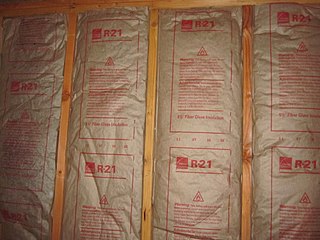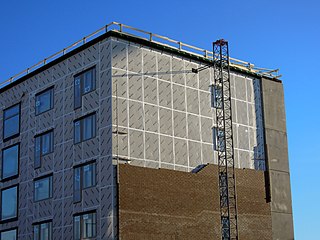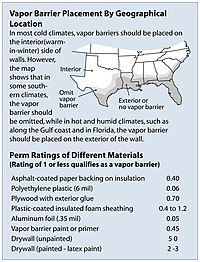
Thermal insulation is the reduction of heat transfer between objects in thermal contact or in range of radiative influence. Thermal insulation can be achieved with specially engineered methods or processes, as well as with suitable object shapes and materials.

In the context of construction, the R-value is a measure of how well a two-dimensional barrier, such as a layer of insulation, a window or a complete wall or ceiling, resists the conductive flow of heat. R-value is the temperature difference per unit of heat flux needed to sustain one unit of heat flux between the warmer surface and colder surface of a barrier under steady-state conditions. The measure is therefore equally relevant for lowering energy bills for heating in the winter, for cooling in the summer, and for general comfort.

A radiant barrier is a type of building material that reflects thermal radiation and reduces heat transfer. Because thermal energy is also transferred by conduction and convection, in addition to radiation, radiant barriers are often supplemented with thermal insulation that slows down heat transfer by conduction or convection.

Waterproofing is the process of making an object or structure waterproof or water-resistant so that it remains relatively unaffected by water or resisting the ingress of water under specified conditions. Such items may be used in wet environments or underwater to specified depths.
Low emissivity refers to a surface condition that emits low levels of radiant thermal (heat) energy. All materials absorb, reflect, and emit radiant energy according to Planck's law but here, the primary concern is a special wavelength interval of radiant energy, namely thermal radiation of materials. In common use, especially building applications, the temperature range of approximately -40 to +80 degrees Celsius is the focus, but in aerospace and industrial process engineering, much broader ranges are of practical concern.

Exterior insulation and finish system (EIFS) is a general class of non-load bearing building cladding systems that provides exterior walls with an insulated, water-resistant, finished surface in an integrated composite material system.

Superinsulation is an approach to building design, construction, and retrofitting that dramatically reduces heat loss by using much higher levels of insulation and airtightness than normal. Superinsulation is one of the ancestors of the passive house approach.
A building envelope is the physical separator between the conditioned and unconditioned environment of a building including the resistance to air, water, heat, light, and noise transfer.

Housewrap, also known by the genericized trademark homewrap, generally denotes a modern synthetic material used to protect buildings. Housewrap functions as a weather-resistant barrier, preventing rain or other forms of moisture from getting into the wall assembly while allowing water vapor to pass to the exterior. If moisture from either direction is allowed to build up within stud or cavity walls, mold and rot can set in and fiberglass or cellulose insulation will lose its R-value due to heat-conducting moisture. House wrap may also serve as an air barrier if it is sealed carefully at seams.

Building insulation is material used in a building to reduce the flow of thermal energy. While the majority of insulation in buildings is for thermal purposes, the term also applies to acoustic insulation, fire insulation, and impact insulation. Often an insulation material will be chosen for its ability to perform several of these functions at once.

Damp proofing in construction is a type of moisture control applied to building walls and floors to prevent moisture from passing into the interior spaces. Dampness problems are among the most frequent problems encountered in residences.

Building insulation materials are the building materials which form the thermal envelope of a building or otherwise reduce heat transfer.

A crawl space is an unoccupied, unfinished, narrow space within a building, between the ground and the first floor. The crawl space is so named because there is typically only enough room to crawl rather than stand; anything larger than about 1 to 1.5 metres and beneath the ground floor would tend to be considered a basement.

Cellulose insulation is plant fiber used in wall and roof cavities to insulate, draught proof and reduce noise. Building insulation in general is low-thermal-conductivity material used to reduce building heat loss and gain and reduce noise transmission.
Air barriers control air leakage into and out of the building envelope. Air barrier products may take several forms:

Pipe Insulation is thermal or acoustic insulation used on pipework.

Rigid panel insulation, also referred to as continuous insulation, can be made from foam plastics such as polyurethane (PUR), polyisocyanurate (PIR), and polystyrene, or from fibrous materials such as fiberglass, rock and slag wool. Rigid panel continuous insulation is often used to provide a thermal break in the building envelope, thus reducing thermal bridging.

A rainscreen is an exterior wall detail where the siding stands off from the moisture-resistant surface of an air/water barrier applied to the sheathing to create a capillary break and to allow drainage and evaporation. The rainscreen is the cladding or siding itself but the term rainscreen implies a system of building. Ideally the rainscreen prevents the wall air/water barrier from getting wet but because of cladding attachments and penetrations water is likely to reach this point, and hence materials are selected to be moisture tolerant and integrated with flashing. In some cases a rainscreen wall is called a pressure-equalized rainscreen wall where the ventilation openings are large enough for the air pressure to nearly equalize on both sides of the rain screen, but this name has been criticized as being redundant and is only useful to scientists and engineers.

Joseph Lstiburek is a forensic engineer, building investigator, building science consultant, author, speaker and widely known expert on building moisture control, indoor air quality, and retro-fit of existing and historic buildings.
Interstitial condensation is a type of condensation that may occur within an enclosed wall, roof or floor cavity structure, which can create dampening.

















